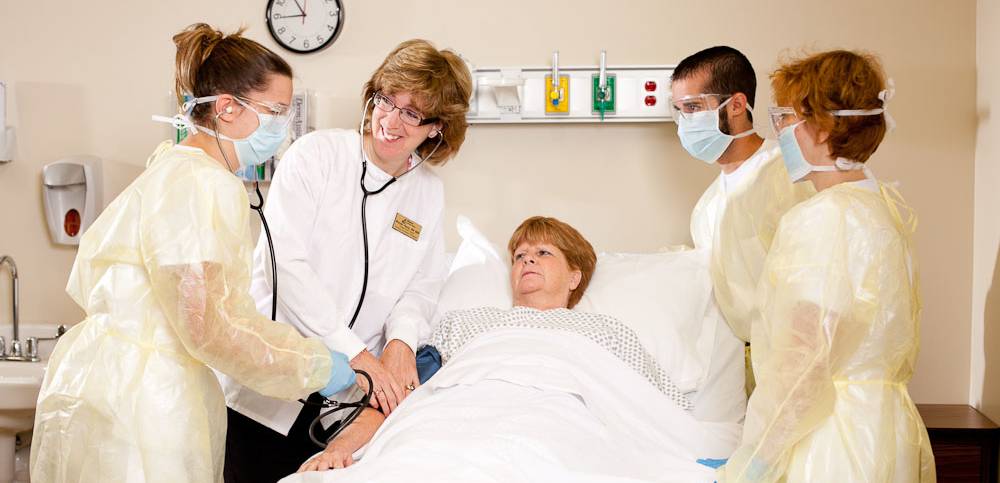Health and Public Services

NURSE AIDE
CERTIFICATE
Are you a natural caretaker? Do you enjoy working with others? If so, ACC’s Nurse Aide program could be a great fit for you!
Nurse aides, also referred to as Nursing Assistants or CNAs, help make sure the patient is receiving the best care possible. Their duties usually include feeding, bathing, dressing, grooming, and changing linens. Individuals who enjoy socializing and helping others might enjoy this career, which requires organizational and problem-solving skills in a hands-on environment.
Essential Functions and Technical Standards for Nurse Aide Students
Purpose Statement:
The following technical standards represent the essential nonacademic requirements
of the Nurse Aide Program that a student must master to successfully participate in
the program and become employable. In adopting these standards the Nurse Aide Program
is mindful of the patient’s right to safe and quality health care by students. The
Nurse Aide student must be able to apply the knowledge and skills necessary to function
in a broad variety of clinical situations while providing the spectrum of nurse aide
interventions. These standards do reflect what may be required for employment of the
graduate. To verify the students’ ability to perform these essential functions, students
may be required to demonstrate the technical standards/essential functions below.
Meeting these technical standards does not guarantee employment in this field upon
graduation. Ability to meet the program’s technical standards does not guarantee a
student’s eligibility for any licensure, certification exam, or successful completion
of the program.
Technical Standards |
Definition of Standards |
Examples |
| Critical Thinking/Problem-Solving Skills | Ability to collect, interpret and integrate information and make decisions within range of function |
While maintaining safety:
|
| Interpersonal Skills | Ability to collaboratively work with students and program faculty in the classroom, lab and clinical setting, as well as employers, community members and host sites. |
While maintaining safety:
|
|
Professionalism/Professional Boundaries |
A skill or behavior that shows consideration and respect for others. |
While maintain safety:
|
| Coping Skills |
Works under time constraints. Concentrates in distracting situations.
|
While maintain safety:
|
| Communication Skills | Express him/herself effectively in English using verbal, nonverbal and written format with faculty, students, patients, families and other health care workers. |
While maintain safety:
|
| Mobility/Motor Skills | Good dexterity (eye and hand coordination) Sufficient gross and fine motor skills to manipulate equipment lift stoop or bend during the safe delivery of care. Sufficient strength to assist patients that have physical limitations. |
While maintain safety:
|
|
Sensory
|
Sufficient eyesight to observe patients, read charts and records. Read equipment. Visually monitor patients in dim lighting. Listening skills sufficient to communicate with others. Sufficient hearing to communicate with patients and members of the health care delivery team, monitor patients using electronic equipment. Identify various sounds. Ability to touch and locate anatomy on patients to perform physical assessments. Ability to tolerate various odors. |
While maintain safety:
|
|
Environmental/Occupational Exposure |
Frequent exposure to communicable and infectious diseases, secretions, blood and bodily fluids. Exposure to environmental hazards. Possible exposure to X-ray radiation. Ability to work under high stress situations and respond promptly. Work in confined spaces |
While maintain safety:
|
|
Behavioral/Emotional |
Shows respect for self and others. Projects an image of professionalism and strong work ethic. Arrives on time for professional commitments. |
While maintain safety:
|
Alamance Community College is committed to providing equal educational opportunities for students with documented disabilities. Students who require accessibility services or reasonable accommodations must identify themselves as having a disability and provide current diagnostic documentation to the Accessibility Services Office located in the Main Building, Room 233. All information is confidential.
Please contact the Accessibility Services Coordinator for more information at 336-506-4130 or email at accessibilityservices@alamancecc.edu and notify your course instructor of your special needs, as appropriate. Students should initiate this process as soon as possible (prior to the start of classes and/or field experience).
|
Nurse Aide Program Estimated Costs and Fees |
|
|
Student Activity Fee |
$35.00 |
|
Curriculum Instructional Technology Fee |
$27.00 |
|
College Access, Parking & Security (CAPS) Fee |
$18.00 |
|
Student Accident Insurance |
$1.00 |
|
Books |
$250.00 |
|
Background and drug screening, uniforms, shoes, watch, TB testing and other immunizations as needed |
$400.00 |
|
State exam |
$140.00 |
|
Malpractice Insurance |
$32.00 |
|
|
|
|
*Does not include cost of tuition. Tuition will vary from semester to semester depending on the number of credit hours taken. |
|
|
|
|
|
Have you applied for Financial aid? Please visit Financial Aid for instructions |
|
 |
Want to get job ready fast?Check out ACC's short-term worksforcre training Nurse Aide options today!
|
Questions? Contact Us.
Rhonda Pierce
Department Head, Nurse Aide
rkpierce593@alamancecc.edu
336-506-4253
Location
H123
Why Wait?YOU BELONG HERE |